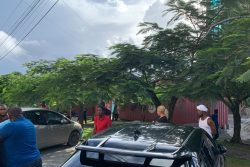The Customs and Trade Administration (CTA) has held a man believed to be the shipper of the container of logs in which five bags of cocaine were found in Jamaica last week.
Sources told Stabroek News that CTA officials were questioning the man and up to late last evening neither ranks from the Guyana Police Force or the Customs Anti-Narco-tics Unit (CANU) had been called in to handle the investigation.
This newspaper was told that while the police and CANU can charge persons with drug-related offences, the CTA, which is an arm of the Guyana Revenue Autho-rity (GRA) cannot do so. Sources said it was surprising neither of the two law enforcement entities had been called in to handle the investigation.
This newspaper also learnt that CANU has been told that it should handle the investigation, but no official documentation had been handed over. “We have seen no documentation, nothing, and as such we have not started any investigation,” a source told this newspaper. CANU ranks were removed from wharves last April and the responsibility for the inspection of all incoming and outgoing vessels was assumed by the CTA.
Last week Wednesday, Jamaican customs authorities discovered the five bags containing 122.65 kgs of cocaine with a street value of $700 million among timber in a container on the MV Vega Azurit. Reports had indicated that the vessel, which left from the John Fernandes Wharf, is one that frequents Guyana almost twice weekly. It had arrived in Guyana on March 11 and left the following day.
Commissioner General of the GRA Khurshid Sattaur on Monday said that only a detailed investigation could identify at what point the cocaine was placed in the container. “…The logs and the containers were handled by several persons and agencies starting with the exporters and ultimately ending with the shippers. A breach could have taken place at any point in that chain and only a detailed investigation would identify at what point the cocaine was placed in the container,” Sattaur had said in a statement.
The statement said the GRA had called for a proper and detailed investigation into the March 12 bust and added that recent suggestions that officers from the CTA may be implicated “are at best premature since preliminary investigations conducted separately by the GRA and the Guyana Forestry Commission (GFC) point to several discrepancies in the way the shipment of the logs was handled at different times by different agencies.”
On Friday last, Sattaur told this newspaper that customs did not check the container in which the five bags of cocaine were found, but that the logs were cleared by the GFC.
Last weekend, GFC Commissioner James Singh, in a letter to Sattaur, said that documentation provided clearly show that customs received the customs declaration (C72) forms on March 1 and gave the “ok to load” on March 2 to the examining officer who then examined and sealed the containers including the cocaine container – ZCSU 8316084 – on March 11.
Singh also revealed that the container was switched to the MV Vega Azurit, after being originally booked to leave these shores on another ship. He said some time after the GFC checked the documents, which were then submitted to the shipping company and the CTA, the vessel’s name listed on the form was changed from the MV Stadt Rotenburg to the MV Vega Azurit. Singh added that since the bust, the GFC learnt from the Jamaican authorities that the cocaine was found in the container with number ZCSU 8316084, which was then traced to the John Fernandes Wharf and which was shipped by ZIM Integrated Shipping Services Ltd and confirmed as being shipped on MV Vega Azurit on March 12. “This container number was listed on export documents covering a shipment of logs by the Aroaima Forest Producers Association (AFAPA) Export Licence BER 05602011 which was slated for shipment via MV Stadt Rotenburg,” Singh said in the letter.
He added that the produce was graded and inspected in Aroaima and a GFC Grading Inspector signed off the Timber Marketing Certificate (TMC) document on February 18, stating that 180 pieces of logs were inspected. The Aroaima Company on February 25 applied to the GFC for an export certificate to export 130 pieces of the already inspected 180 logs.
Singh said based on the fact that the produce was independently verified and checked by the GFC grading inspector, the GFC approved the export certificate.
The GFC’s investigation also discovered that while CTA checked and sealed seven containers on February 28, eight containers were stated on the C72 form.








